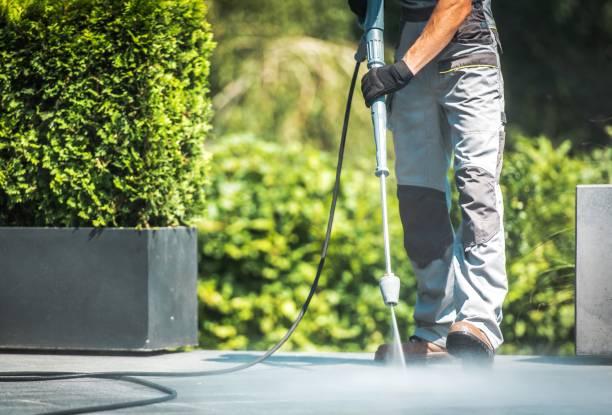Driveways and patios are concrete-made surfaces that endure dirt, spillages, and even general wear over time. As professional washers, we suggest concrete pressure washing as the best solution for the upkeep of your concrete surfaces. If you are thinking of concrete pressure washing to maintain the health of your slab, you should know all the advantages, disadvantages, and recommended approaches.
So, let’s dig in and find out if Pressure Washing is Good for Your Concrete Slab.
The Top 5 Reasons Pressure Washing Is Great for Concrete
-
Brings Back Your Concrete’s Shine
Concrete pressure washing brings back the beauty of your slab. It scales off the dirt, oil stains, and grime and makes your concrete surfaces look like new again.
-
Stops Long-Term Damage Before It Starts
Pressure washing your concrete slabs helps prevent future damage. Dust, fungi, and other forms of debris may hold water and, as a result, cause either crack formation or erosion. Pressure washing clears these threats, and extends the life of concrete slab.
-
Adds Years to Your Concrete’s Life
Regular pressure washing removes harmful substances that cause deterioration. It delays the need for costly repairs and keeps your slabs in good condition for a longer time.
-
Makes Your Slab Safer
Pressure washing wipes away slippery elements like moss, algae, and grease, preventing the risks of falls and injuries on wet surfaces.
-
Environmentally Friendly Cleaning Solution
Pressure washing is an eco-friendly cleaning option. Most pressure-washing jobs are done without harsh chemicals, as water pressure alone does the magic!
Beware: Pressure Washing Concrete Has Its Risks, Too
-
Surface Damage Risks
Excessive force or being too close to the nozzle will harm your concrete either through etching or chipping, especially if you are washing old concrete surfaces.
-
Sealant Stripping
Pressure washing can remove protective sealants, leaving your slab more defenseless to stains and damages. For extended longevity of your concrete slabs, consider resealing them after washing.
-
Worsening Cracks
High-pressure water can aggravate an existing crack and cause additional problems to the structure. Water gets trapped in cracks. It freezes and expands, making cracks widen over time.
-
High Water Usage
Pressure washers use a lot of water, which can lead to water issues in areas with water restrictions or droughts. So, always remember the rules of water conservation if you are cleaning a large area. It’s better to be careful!
Want to Pressure Wash Concrete? Here’s How to Do It Right
So, are you inclined to choose pressure washing for your concrete slabs? Here are some guidelines to make the cleaning process less complex for you.
-
Get the Pressure Just Right
When it comes to concrete pressure washing, the correct pressure is key. A pressure range of 2500- 3000 is typically powerful enough to clean but not destroy the surface of the object being cleaned. Do not go beyond this limit, or you’ll end up with a chipped surface.
-
Use the Right Nozzle for Even Cleaning
To reduce the risk of damaging the concrete slabs, you need to distribute the pressure evenly. Use fan-shaped nozzles for better cleaning without damage. A fan-shaped nozzle (25-40 degrees) is the best choice for cleaning concrete.
-
Always Test First
Rather than applying the pressure all over the slab, first try it on a small, discreet area. This will help you pick up the best washer settings while avoiding any damage to your slabs.
-
Use a Cleaner for Tough Stains
Usually, water alone suffices your pressure-washing process, but not if you’re dealing with oil or grease spots. When faced with solid dirt, use a concrete-safe cleaner together with the pressure washer.
-
Seal Your Concrete After Cleaning
It’s wise to reseal your concrete slabs after pressure washing. The sealants not only make the slab appear new but also provide a shield for future work and stains.
Not Sold on Pressure Washing? Here Are Some Alternatives
Regular sweeping and spot cleaning might reduce the need for pressure washing. A broom and some elbow grease go a long way in preventing build-up. If you are worried about damaging your slab, low-pressure washing might be a safer choice. It uses less pressure and often includes a cleaning solution to lift dirt and stains gently.
When Should You Avoid Pressure Washing Concrete?
-
Skip Pressure Washing on New Concrete
If your concrete slab is new, you should refrain from pressure washing for at least a year. These concrete pavements, when prepared with new cement, require a period of curing, and washing them immediately will compromise the surface or even damage the material.
-
Fragile or Cracked Concrete? Be Careful!
If your slab is already showing signs of wear or has visible cracks, then pressure washing will damage it more. The high pressure of water can make cracks worse, damaging your already weak concrete structure.
The Final Verdict: Is Pressure Washing Good for Concrete?
So, here we are with all the know-how of pressure washing! As an expert pressure washer company, TN Wash suggests you opt for Concrete pressure washing. It restores your slab’s look and prevents long-term damage. Plus, it offers a green cleaning solution.
However, it’s essential to approach it with care. If you play it smart with the right tools and techniques, pressure washing is a great way to keep your concrete slab in excellent condition.
So, embrace the elegance and allure of your concrete structures with pressure washing and extend their life.



































